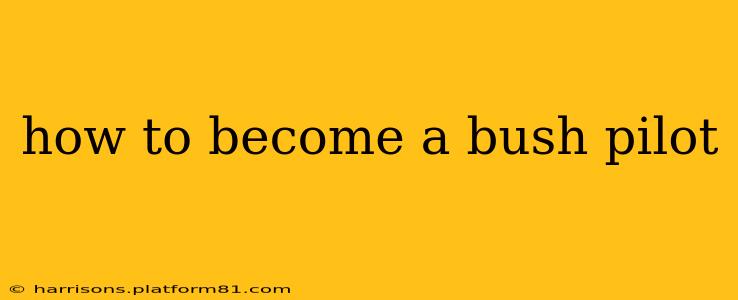The romantic image of a bush pilot, soaring over rugged terrain, landing on remote airstrips, and delivering vital supplies, captures the imagination of many. But the reality of becoming a bush pilot requires dedication, rigorous training, and a deep understanding of aviation and wilderness survival. This guide will walk you through the essential steps to achieve this challenging yet rewarding career.
What Does a Bush Pilot Do?
Before diving into the how-to, let's clarify what a bush pilot does. Bush pilots operate in remote and often challenging environments, requiring specialized skills beyond those of a typical commercial pilot. Their responsibilities include:
- Passenger and Cargo Transport: Delivering people and goods to isolated communities, mining operations, or research stations.
- Aerial Surveys and Photography: Conducting aerial surveys for resource management, geological exploration, or wildlife monitoring.
- Emergency Medical Services (EMS): Providing critical medical transport in remote areas, often known as air ambulances.
- Search and Rescue (SAR): Assisting in search and rescue operations in challenging terrains.
- Aircraft Maintenance: Often performing basic maintenance tasks on their aircraft due to remoteness.
The work is demanding, requiring adaptability, quick thinking, and exceptional flying skills under varied and sometimes precarious conditions.
What are the Requirements to Become a Bush Pilot?
The path to becoming a bush pilot involves several key steps:
1. Obtain a Private Pilot License (PPL)
This is the foundation of any piloting career. You'll learn basic flight maneuvers, aircraft systems, meteorology, and air regulations. Expect rigorous flight training and examinations.
2. Obtain a Commercial Pilot License (CPL)
A CPL expands on your PPL, allowing you to carry passengers and cargo for compensation. This involves more advanced training, including multi-engine aircraft operation and instrument flight rules (IFR).
3. Gain Experience
After obtaining your CPL, accumulate significant flight hours. The exact number varies depending on the country and specific requirements, but several hundred hours are typically necessary. This experience should ideally include diverse flying conditions to build your skills and confidence.
4. Obtain Relevant Ratings and Endorsements
Depending on your chosen area of operation and aircraft type, specific ratings and endorsements may be required. These could include:
- Multi-Engine Rating (ME): Allows you to fly aircraft with more than one engine.
- Instrument Rating (IR): Enables you to fly in instrument meteorological conditions (IMC).
- Floatplane Rating: Necessary for flying seaplanes or aircraft equipped with floats.
- High-Altitude Endorsement: For flying at higher altitudes.
- Night Rating: Permits flight operations at night.
5. Specialized Bush Flying Training
This is arguably the most crucial step. You need specialized training focused on short take-offs and landings (STOL) techniques, wilderness survival, navigation in challenging terrains, and emergency procedures specific to bush flying. Look for reputable flight schools that offer comprehensive bush flying programs.
6. Obtain a Type Rating (if necessary)
Depending on the type of aircraft you intend to fly, you may require a type rating. This certification demonstrates proficiency in operating a specific aircraft model.
7. Gain experience in a remote environment.
What Type of Aircraft Do Bush Pilots Fly?
Bush pilots often fly rugged, versatile aircraft designed for short take-offs and landings (STOL) and challenging conditions. These aircraft are typically high-wing, single-engine aircraft capable of operating from unimproved airstrips. Popular choices include Cessna 185, Cessna 206, De Havilland Canada DHC-2 Beaver, and De Havilland Canada DHC-3 Otter.
How Much Does it Cost to Become a Bush Pilot?
The cost of becoming a bush pilot varies greatly depending on your location, the type of training you undergo, and the number of flight hours you accumulate. It's a substantial financial investment, and realistic budgeting is crucial.
What are the Qualities of a Successful Bush Pilot?
Beyond technical skills, successful bush pilots possess:
- Exceptional flying skills: Precise handling, quick reactions, and adaptability to changing conditions.
- Strong problem-solving abilities: The ability to handle unexpected situations and mechanical issues.
- Excellent navigation skills: Proficiency in using various navigation tools, including charts, GPS, and dead reckoning.
- Wilderness survival skills: Knowledge of survival techniques in case of emergency landings in remote areas.
- Physical and mental fitness: The ability to endure long hours, challenging conditions, and the pressures of the job.
- Adaptability and resilience: Ability to handle unforeseen circumstances, isolation, and varied weather patterns.
How Long Does it Take to Become a Bush Pilot?
The timeline for becoming a bush pilot varies, but it can take several years of dedicated training and experience accumulation.
What is the job outlook for bush pilots?
The demand for bush pilots varies depending on geographical location and economic factors. It’s important to conduct thorough research before committing to this career path.
This comprehensive guide provides a solid foundation for aspiring bush pilots. Remember, the journey requires dedication, perseverance, and a genuine passion for aviation and remote environments. Always prioritize safety and continuous learning throughout your career.
